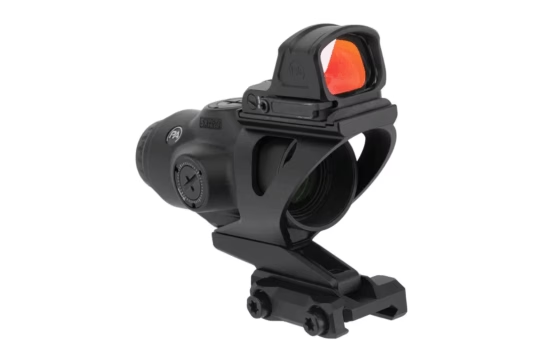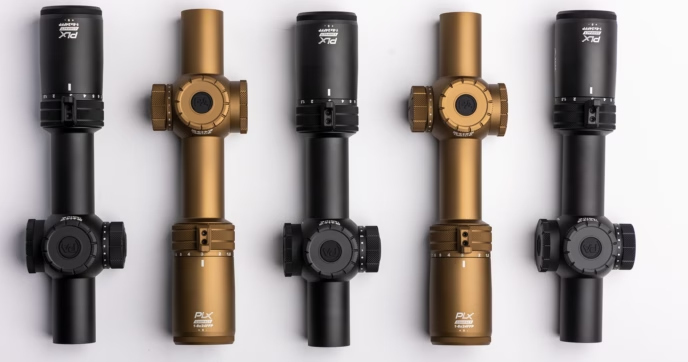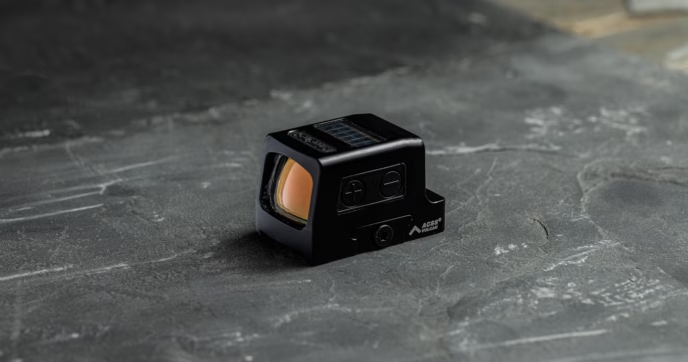If you’ve followed the Primary Source for any given time, you’ll know that we have a large swath of articles dedicated solely to highlighting the intricacies of different optics. And while we go into great detail on their core features and functionality, it isn’t always possible to highlight every detail of every optic.
And this is especially the case when going over the optic lineup of Primary Arms Optics. Simply put, they offer something for everyone, with their list of offerings including everything from red dots to variable power optics, and everything in between. And one of their optic lines that consistently remains among their most popular, is their prism scopes.
Welcome to our new series: Behind the Glass! In this series, we’re going to look at all the optics PAO offers. And to kick it off, we’ll be starting with one of the most popular optic lines they offer: prism scopes.

What is A Prism Scope?
Prism scopes are a type of rifle optic that uses a glass prism to provide low-level magnification. Unlike conventional rifle scopes, which use a series of glass lenses, prism scopes are much more compact but are fixed at a single magnification power.
This design has many unique advantages. Compared to rifle scopes, the overall footprint and size of most PAO prism scopes is generally on par with reflex sights, making them a lightweight alternative to bulkier variable power scopes. And compared to reflex sights, prism scopes have the advantage of being unaffected by astigmatism, an eye condition affecting roughly 33% of people and the main cause red dot reticle distortion.
As mentioned above, PAO prism scopes use etched reticles, meaning the reticle is physically etched into the lens rather than projected onto it. As such, they’re capable of housing complex reticle designs, and since they’re etched, they aren’t susceptible to astigmatic distortions like reflex sights, meaning your reticle will always be crisp. PAO prism scopes have an adjustable diopter ring too, allowing you to best adjust the reticle’s clarity to whatever works best for your eyes.
Prism scopes come with a fixed magnification level instead of a variable one, meaning you’ll be locked into just one magnification level. However, depending on how you intend to use your rifle, this can be quite advantageous. Different magnification levels offer different levels of performance across different applications, something we’ll cover further below.

Why Choose a Primary Arms Optics Prism Scope?
Currently, there are a lot of prism scope options available on the market, so you’re likely wondering “why should I go with a PAO prism over another option”? Well, PAO has been at their craft for quite some time, and their commitment to crafting innovative optics has proven repeatedly. Perhaps that’s why Primary Arms Optics has been one of the best-selling prism scope brands in America for the better part of a decade.
Every PAO optic is made from high-quality materials and components, and they all go through rigorous quality control checks to ensure they’re ready to be used to their fullest extent. Additionally, these optics are currently available in both PAO’s SLx® and GLx® optic tiers. We go over each tier in our guide, “Explaining the Primary Arms Optics Tier System”, but the gist is that PAO offers something for everyone, no matter if you’re looking for a budget-friendly optic that doesn’t compromise on quality, or if you need a professional grade optic for demanding conditions.
PAO prism scopes usually feature the Advanced Combined Sighting System, better known as just the ACSS® Reticle Family. The ACSS Reticle family is made up of several unique reticles, and for PAO prism scopes, they can have either a BDC- or MIL-based reticle designed for ranged applications, or simpler designs that forego subtensions in favor of elements that are better suited for fast target acquisition such as the reticles found on their 1x prisms. So, whether you’re in need of a solid optic for your AR-15 or want the Advantages of Using a Prism Scope for Hunting, you have plenty of options to choose from.
Primary Arms Optics Prism Scopes
As we’ve mentioned above, there are a lot of prism scopes offered by PAO and depending on what you plan to use your rifle for, it’s important to know how each one performs, as well as what reticle it uses. So, to get a better idea of the different prism scopes found in their lineup, we’ve compiled a list of them below:
The SLx Series: Proven Reliable and Affordable
PAO’s SLx series optics are designed to offer premium quality, without the premium price tag. Much like their other optics, they go through rigorous quality control inspections to ensure that they’re ready to perform in all conditions, and since they aren’t as pricey as other prism scopes, they’re a solid choice for everyone from newcomers to seasoned enthusiasts.

SLx 1x MicroPrism
One of the most popular optics offered by PAO, the SLx 1x MicroPrism Scope effectively changed when it was first released. Compared to their earlier Compact 1x Prism Scope, the SLx 1x MicroPrism is nearly half the size and just over 20% lighter, with it coming in at just 5.5 ounces (or 7.6 ounces when using the included riser). As such, it’s incredibly agile, offering a level of performance that’s on par with reflex sights.
These optics come with either the ACSS Cyclops Gen II or the ACSS Gemini® reticle system. Both reticles are incredibly useful in close-range applications—they have an infinitely precise center chevron instead of a dot, an outer horseshoe for fast target acquisition, and built-in ranging stadia for taking shots at distance. The biggest difference between the two is that the ACSS Gemini reticle is a dedicated 9mm reticle, making it best suited for PCCs. Regardless, these optics are in their element when used for dedicated close-range applications, but something that separates the SLx 1x MicroPrism from other prism scope models is that it was designed with magnifier to use in mind.
Just like a reflex sight, you can mount a magnifier behind the optic, allowing you to easily switch from a magnified to non-magnified just by shifting the magnifier’s position. Under magnification, the built-in ranging stadia becomes much more useful, allowing for some added versatility when engaging targets at further distances.
Lastly, these optics are available with either a red or green reticle, both of which come with 13 daylight brightness settings, as well as 3 dedicated night vision ones. Plus, the fact that these optics have long battery lives, AutoLive® motion-sensing illumination, an automatic shutoff, are waterproof, shock- and fog-resistant, and come with multiple riser heights, they’re a solid optic fit for all budgets priced around $265.
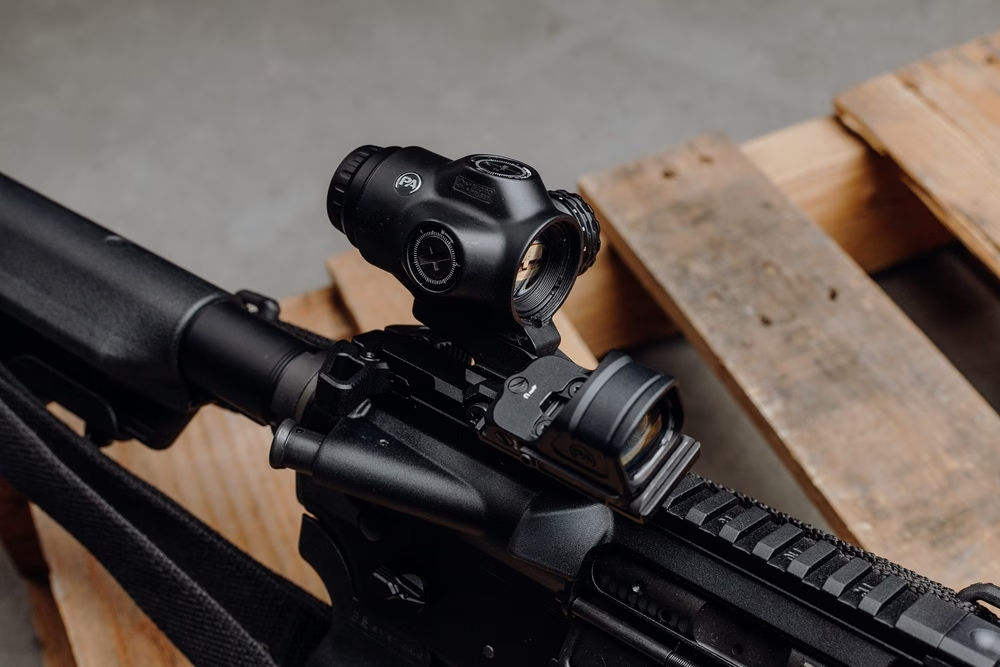
SLx 3x MicroPrism Scope
For those wanting more reach, the SLx 3x MicroPrism is another solid choice to consider. Boasting many of the same advantages of the 1x MicroPrism mentioned above, it has the distinct advantage of having a 3x fixed magnification, as well as a more specialized reticle tailored for both close- and medium-distance engagements.
More specifically, the SLx 3X MicroPrism ACSS Raptor Reticle – 5.56 /.308, as its name would suggest, comes equipped with the ACSS Raptor reticle system. A BDC reticle, it shares many characteristics in common with the ACSS Cyclops, such as the outer horseshoe and center chevron, but it comes with an auto-ranging BDC specifically for 5.56 NATO and .308 Winchester. This reticle is also available in two configurations, one that measures in 100-yard increments, and another that measures in 100-meter increments.
Since this optic has a fixed 3x magnification, it does lose out slightly in terms of agility. Compared to 1x prisms, it has a less forgiving eye box and isn’t compatible with magnifiers. That said, it does fall within the visual sweet spot that allows you to comfortably aim with both eyes open, and it’s compatible with PAO’s 12 O’clock reflex sight mount, meaning you could easily switch over to a non-magnified optic just by shifting your head position. Overall, it’s a well-rounded optic that offers a nice blend of close-range agility and medium-range adaptability.
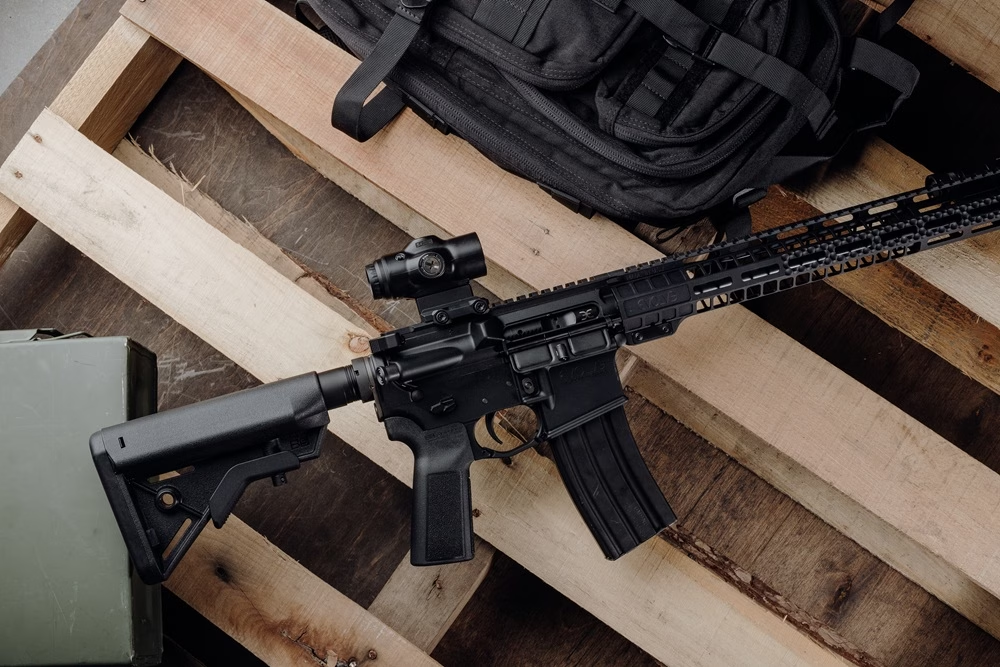
SLx 5x MicroPrism Scope
For dedicated medium- to long-range applications, the SLx 5x MicroPrism Scope is one of the best optics for the job, especially if you want an optic that provides long-range utility without the bulk of an LPVO. Just like the earlier optics mentioned thus far, the SLx 5x MicroPrism is a rugged optic that’s ready for use in all conditions. Coming equipped with the venerable ACSS Aurora® reticle system, they’re offered in either a MIL- or BDC-based configuration.
The SLx 5X MicroPrism™ ACSS Aurora MIL Reticle makes use of MIL-based measurements. Unlike the other reticles listed above, the ACSS Aurora has a unique design that better caters to long-range shooting disciplines. It keeps the infinitely precise center chevron but forgoes the outer horseshoe in favor of a series of vertical ranging stadia and a mil-grid for making more precise holds at distance. Meanwhile, the SLx 5x MicroPrism ACSS Aurora 5.56/.308 model has a similar overall reticle design, but the MIL grid has been swapped out for a BDC ladder with windage holds.
Being a dedicated 5x optic, this MicroPrism isn’t all that suited for close-range engagements. Its higher magnification gives it a more constrictive eye box, making it best suited for rifle builds that prioritize medium to long-range accuracy. As such, they’re a solid choice for dedicated long-range AR builds, and hunting rifles such as Lever Actions. Still, just like the SLx 3x Prism, the SLx 5x MicroPrism is compatible with the same 12 O’clock mount, allowing you to run an offset mini-reflex sight, if you want.
The GLx Series: Premium Performance and Glass Clarity
A step up in quality, PAO’s GLx series optics are offered as a mid-range tier that will provide you with added features you’d expect to find in higher quality optics, all while remaining in a rather approachable price range. As far as prism scopes go, PAO has a couple to choose from in the GLx line.

GLx 1x MicroPrism
Hitting the scene in September of 2024, the GLx 1x MicroPrism Scope is one of the newest entrants of the MicroPrism line of optics. We have a breakdown of it in our Primary Arms GLx 1x Product Release, but the GLx 1x MicroPrism has quite a few notable upgrades that make it stand out compared to other prism scopes.
For starters, it has near-unlimited eye relief, meaning its performance is even closer to that of a reflex sight, and it makes use of push-button controls rather than a rotary knob, giving it a slimmer overall profile. Additionally, it has a larger objective lens and comes standard with fully multi-coated lenses for optimal clarity and light transmission.
These upgrades make it a solid pairing for rifles like the AR-15 and AR-10 as its more robust construction gives it an edge in terms of overall durability. And much like the SLx 1x Prism, it comes standard with many of PAO’s premium features like AutoLive motion sensing illumination, 13 brightness settings, including 3 night vision compatible ones, a long battery life, and it uses the ACSS Cyclops reticle system. Plus, you can always opt for the GLx 1x MicroPrism – Green, if you prefer having a green reticle.

GLx 2x Prism Scope
Despite being one PAO’s older optics, the GLx 2X Prism Scope – ACSS CQB-M5 Reticle – 5.56 / .308/ 5.45 remains a popular choice amongst prism scope enthusiasts. A rugged optic, the GLx 2x Prism Scope makes use of PAO’s older prism scope design, but that doesn’t mean that it compromises quality.
Much like the other optics in the GLx line, it’s constructed from exceptionally durable aluminum housing, has premium glass with impressive clarity, making it a solid pick for many applications. Part of what makes this optic so popular still is its unique magnification level. Its 2x magnification is much like the SLx 3x MicroPrism in that it falls right within the visual sweet spot that allows you to easily aim with both eyes open. While it isn’t as agile as a 1x prism scope, it’s still more-than-suitable for close-quarters use, while also being great for targets at further distances too. Plus, it makes use of the ACSS CQB-M5 reticle.
This reticle uses a BDC design and has many features that make it useful across different applications. Much like many of the other ACSS reticles used on PAO prism scopes, it has both an infinitely precise center chevron for fine aiming, and an outer horseshoe for fast target acquisition. Below the chevron are two BDC holds calibrated for 5.56 NATO, .308 Winchester, and 5.45×39, and it also has a ranging ladder for estimating your distance to target. Although this optic is heavier than PAO’s MicroPrism Scopes with it weighing 11 ounces, it’s a very well-rounded optic. Plus, it still makes use of the Trijicon Mini-ACOG footprint, making it compatible with a plethora of Primary Arms scope mounts.
Conclusion
Of the many optics found in PAO’s ever-expanding lineup, their prism scopes are easily some of the most unique ones they offer. And with them being backed by their commitment to crafting high-quality optics equipped for versatility across all applications, it’s no surprise that PAO’s prism scopes have gone on to become some of the most popular optics they offer.
Still, a cursory search of PAO’s prism scopes can be a bit overwhelming, especially if you don’t already know what sets them apart from other types of optics. However, now that you know what’s behind the glass, you’ll have no problem narrowing down the right prism scope model for you.
Finally, it’s worth noting that, as we mentioned earlier, prism scopes aren’t the only type of optic offered by PAO. In our next installment of “Behind the Glass”, we’ll be looking into their LPVOs. Stay tuned!
